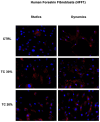Effect of Helichrysum italicum in Promoting Collagen Deposition and Skin Regeneration in a New Dynamic Model of Skin Wound Healing
- PMID: 38731954
- PMCID: PMC11083432
- DOI: 10.3390/ijms25094736
Effect of Helichrysum italicum in Promoting Collagen Deposition and Skin Regeneration in a New Dynamic Model of Skin Wound Healing
Abstract
Natural products have many healing effects on the skin with minimal or no adverse effects. In this study, we analyzed the regenerative properties of a waste product (hydrolate) derived from Helichrysum italicum (HH) on scratch-tested skin cell populations seeded on a fluidic culture system. Helichrysum italicum has always been recognized in the traditional medicine of Mediterranean countries for its wide pharmacological activities. We recreated skin physiology with a bioreactor that mimics skin stem cell (SSCs) and fibroblast (HFF1) communication as in vivo skin layers. Dynamic culture models represent an essential instrument for recreating and preserving the complex multicellular organization and interactions of the cellular microenvironment. Both cell types were exposed to two different concentrations of HH after the scratch assay and were compared to untreated control cells. Collagen is the constituent of many wound care products that act directly on the damaged wound environment. We analyzed the role played by HH in stimulating collagen production during tissue repair, both in static and dynamic culture conditions, by a confocal microscopic analysis. In addition, we performed a gene expression analysis that revealed the activation of a molecular program of stemness in treated skin stem cells. Altogether, our results indicate a future translational application of this natural extract to support skin regeneration and define a new protocol to recreate a dynamic process of healing.
Keywords: Helichrysum italicum; bioreactor; dynamic cultures; fibroblasts; molecular mechanisms; stem cells; tissue regeneration; wound healing.
Conflict of interest statement
The authors declare no conflicts of interest.
Figures





Similar articles
-
Hydrolat of Helichrysum italicum promotes tissue regeneration during wound healing.Physiol Res. 2023 Dec 31;72(6):809-818. doi: 10.33549/physiolres.935101. Physiol Res. 2023. PMID: 38215066 Free PMC article.
-
Regeneration of full-thickness skin defects by differentiated adipose-derived stem cells into fibroblast-like cells by fibroblast-conditioned medium.Stem Cell Res Ther. 2017 Apr 20;8(1):92. doi: 10.1186/s13287-017-0520-7. Stem Cell Res Ther. 2017. PMID: 28427476 Free PMC article.
-
Towards a modern approach to traditional use of Helichrysum italicum in dermatological conditions: In vivo testing supercritical extract on artificially irritated skin.J Ethnopharmacol. 2023 Jan 30;301:115779. doi: 10.1016/j.jep.2022.115779. Epub 2022 Oct 3. J Ethnopharmacol. 2023. PMID: 36202166
-
Helichrysum italicum: from traditional use to scientific data.J Ethnopharmacol. 2014;151(1):54-65. doi: 10.1016/j.jep.2013.11.005. Epub 2013 Nov 14. J Ethnopharmacol. 2014. PMID: 24239849 Review.
-
Helichrysum italicum: From Extraction, Distillation, and Encapsulation Techniques to Beneficial Health Effects.Foods. 2023 Feb 13;12(4):802. doi: 10.3390/foods12040802. Foods. 2023. PMID: 36832877 Free PMC article. Review.
Cited by
-
Natural Products from the Mediterranean Area as Wound Healing Agents-In Vitro Studies: A Systematic Review.Antioxidants (Basel). 2025 Apr 17;14(4):484. doi: 10.3390/antiox14040484. Antioxidants (Basel). 2025. PMID: 40298830 Free PMC article. Review.
-
Counteracting Skin Aging In Vitro by Phytochemicals.J Cell Mol Med. 2025 Apr;29(7):e70530. doi: 10.1111/jcmm.70530. J Cell Mol Med. 2025. PMID: 40181572 Free PMC article.
-
Unlocking the Potential of Hydrosols: Transforming Essential Oil Byproducts into Valuable Resources.Molecules. 2024 Sep 30;29(19):4660. doi: 10.3390/molecules29194660. Molecules. 2024. PMID: 39407589 Free PMC article. Review.
References
MeSH terms
Substances
LinkOut - more resources
Full Text Sources

